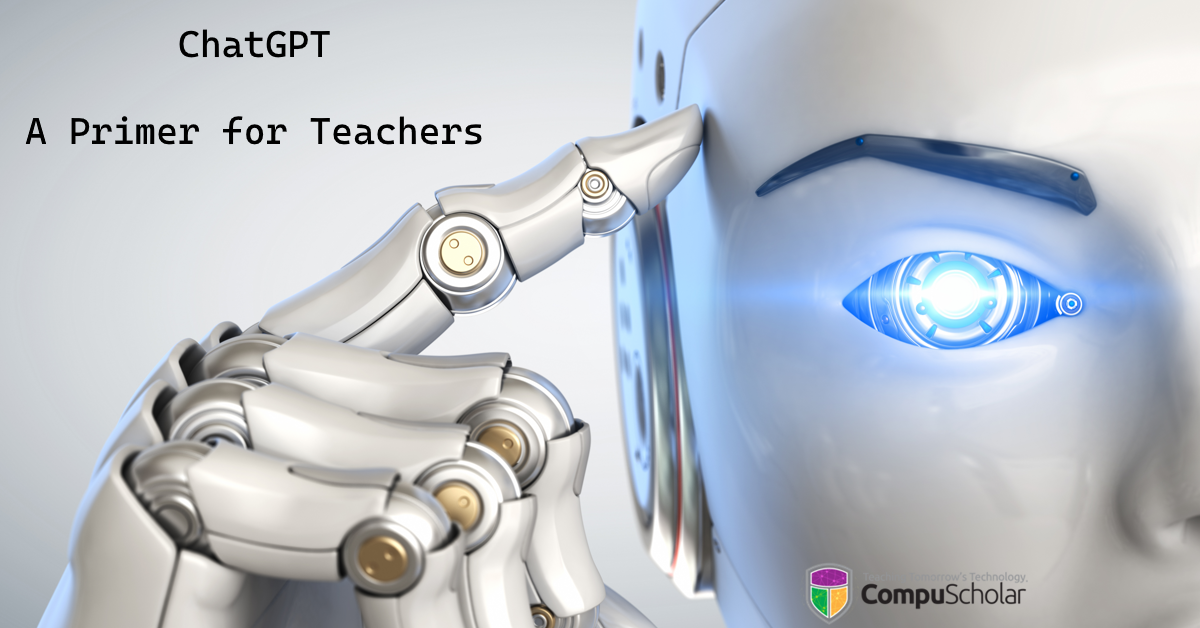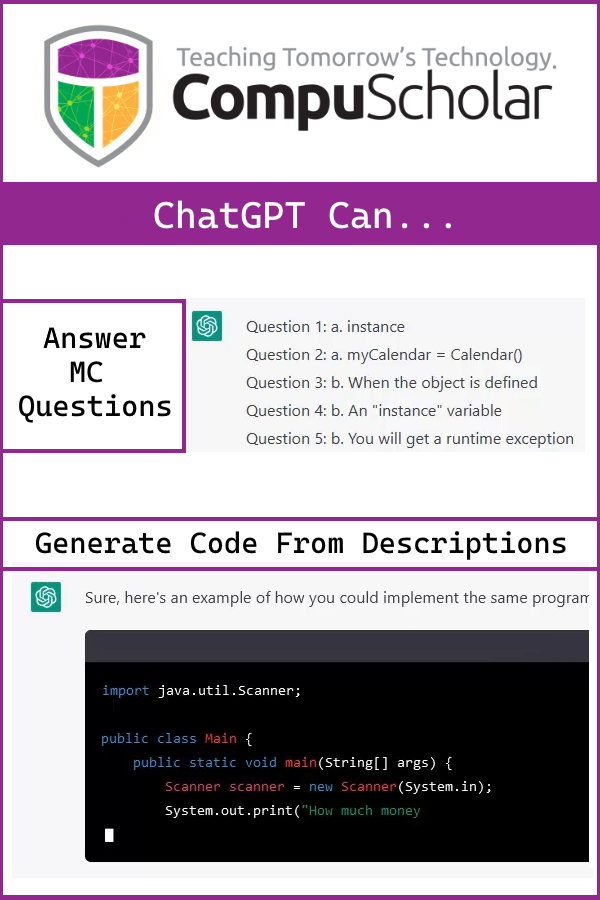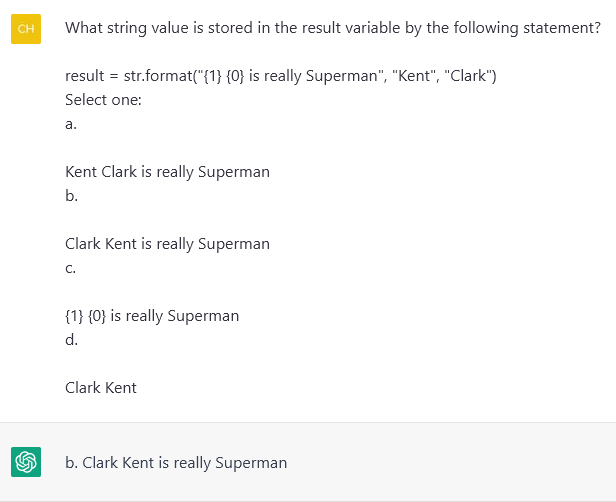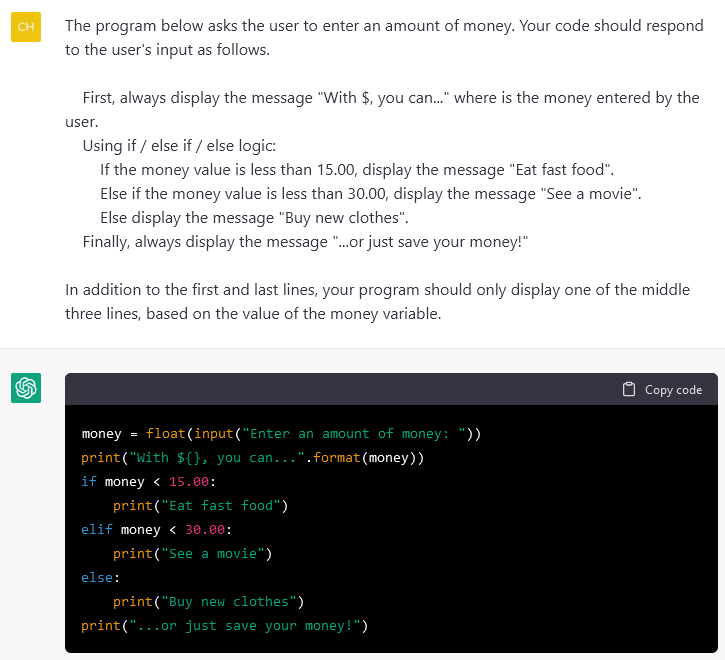
The ChatGPT tool by OpenAI has generated a lot of recent concern about students leveraging AI to cheat on assignments. Let's take a quick tour of this tool to understand what it can do and how we might mitigate student use of AI.
OPENAI PRODUCTS AND SERVICES
ChatGPT is an experimental tool produced by the OpenAI company. OpenAI currently publishes a number of tools intended for business use, including:
- GPT-3 - A natural language processor
- Codex - A code generator
- DALL-E - An image creator and editor
 ChatGPT is currently in "research release", which means they are letting folks use it for free to see how it works in many real-world situations. Naturally, free access means students can use the tool to produce any kind of output the tool supports. ChatGPT can generate essays, answer multiple choice questions, and generate code based on a problem description - among many other tasks.
ChatGPT is currently in "research release", which means they are letting folks use it for free to see how it works in many real-world situations. Naturally, free access means students can use the tool to produce any kind of output the tool supports. ChatGPT can generate essays, answer multiple choice questions, and generate code based on a problem description - among many other tasks.
OpenAI has billions of dollars of investment from companies like Microsoft. It isn't going anywhere, and we expect other companies are working on a variety of AI tools with a similar scale of funding. We believe they will eventually make their money by charging for access, with other businesses being the target market. But for the moment, free student access certainly raises some concerns.
ACCESS AND PRICING
You must create an account to use ChatGPT. The process is free, but does require:
- Name
- Email Address (will receive and must click on validation link)
- Phone# (will be sent a confirmation code via text message)
There is nothing to stop a student from faking a name and possibly creating a throwaway email address for anonymity. However, having to enter a valid phone# and receive a text may help them understand their identity is tied to the account.
ChatGPT is currently free to use (when the server is not overloaded). We expect they will eventually charge access fees if and when the tool becomes a real product. Other OpenAI tools like GPTX-3, Codex and DALL-E have an existing pricing model - check out the OpenAI Pricing Page for details.
SAMPLE OUTPUT
To use ChatGPT, simply copy and paste a question or set of activity instructions into the chat prompt. You'll usually get an answer pretty quickly, and the answer is often correct (depending on the complexity of the problem).

Similarly, you can paste in a coding challenge and, depending on the complexity, get a decent response.

In our experience, questions and challenges of increasing complexity naturally start to cause problems for ChatGPT. Small variations in the input may mean the difference between a bad, decent, or great answer.
MITIGATION STRATEGIES
What can teachers do to keep students from cheating with OpenAI and similar tools? There are a few obvious first steps:
- Block OpenAI domains on school networks
- Prevent VPN / proxy apps from being installed on school devices
- Observe students in-class when doing work
You also might consider educating parents about the potential for AI abuse. Parents can look for the tool use at home and monitor credit cards for unexplained charges (if the "freebie" access goes away).
Talking with students about ChatGPT and similar AI tools naturally might plant ideas where there were none previously. You will likely want to highlight that anything you do online can likely be tracked, and that OpenAI will likely have a record of everything accounts have asked it to generate. Be sure students clearly understand the penalties for AI use or abuse.
Speaking of penalties, those would ideally be spelled out in your Student Code of Conduct. You might equate AI abuse with plagiarism with well-understood penalties to discourage students.
Setting up your own OpenAI account as a teacher will let you better understand how the tool will respond to your particular assignments. The AI tool may have a unique way of answering questions (including variable names, spacing, comments, etc. in code) that can be identified in student work.
We hope that long-term, these AI tools will become too expensive for continuous student use. Their investors certainly want to provide high-dollar services to businesses and not free crutches to students. However, vigilance will certainly be needed as we gain understanding of what these tools can do and how they will be offered in the marketplace.
FOR MORE INFORMATION
Check out our January 2023 Professional Development Webinar - "ChatGPT - A Primer for Teachers" - for further discussion and a video tour ChatGPT. As always, please Contact Us if you have questions!